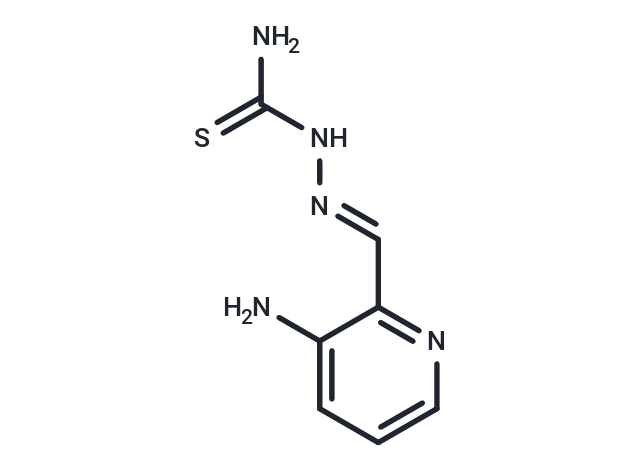Shopping Cart
- Remove All
 Your shopping cart is currently empty
Your shopping cart is currently empty

3-AP (Triapine) is a novel inhibitor of the M2 subunit of ribonucleotide reductase (RR).

| Pack Size | Price | Availability | Quantity |
|---|---|---|---|
| 2 mg | $33 | In Stock | |
| 5 mg | $52 | In Stock | |
| 10 mg | $63 | In Stock | |
| 25 mg | $153 | In Stock | |
| 50 mg | $277 | In Stock | |
| 100 mg | $422 | In Stock | |
| 500 mg | $957 | In Stock | |
| 1 mL x 10 mM (in DMSO) | $52 | In Stock |
| Description | 3-AP (Triapine) is a novel inhibitor of the M2 subunit of ribonucleotide reductase (RR). |
| In vitro | Triapine is a potent derivative of α-heterocyclic carboxaldehyde thiosemicarbazone (HCT) that inhibits hRRM2 and p53R2 isoforms of the M2 subunit[1]. Triapine is thought to inhibit ribonucleotide reductase through its preformed iron chelate, rather than directly by removing iron from the active site. In cells containing less topoisomerase IIα fewer DNA strand breaks will be produced, and thus topoisomerase II poisons will be less inhibitory in the K/VP.5 cell line. The IC50s for Dp44mT growth inhibition are 48±9 nM and 60±12 nM, for K562 and K/VP.5 cells, respectively. The IC50s for Triapine growth inhibition are 476±39 nM and 661±69 nM for K562 and K/VP.5 cells, respectively[2]. PKIH and DpT Fe chelators show high antiproliferative activity against a range of tumor cell lines. Dp44mT shows the greatest antitumor efficacy with an IC50 that ranged from 0.005 to 0.4 μM. The average IC50 of Dp44mT over 28 cell types is 0.03±0.01 μM, which is significantly lower than that of Triapine (average IC50: 1.41±0.37 μM)[3]. |
| In vivo | Triapine administration results in a significant 1.7-fold rise in the ratio of spleen to total body weight (1.02±0.06%; n=25) compared with controls (0.6±0.03%; n=27). For mice treated with Dp44mT (0.4 mg/kg per day), there is a notable increase in heart weight (0.8±0.06%; n=4) relative to controls (0.5±0.01%; n=6). Additionally, a significant reduction in the liver expression levels of Ndrg1, TfR1, and VEGF1 is observed in animals treated with both Dp44mT and Triapine (12 mg/kg per day). This decrease in expression may be attributed to elevated liver iron levels found in mice receiving Dp44mT and Triapine treatments[3]. |
| Kinase Assay | Ribonucleotide reductase assay: CDP reductase is assayed using Dowex 1-borate ion-exchange chromatography. The assay mixture contains 0.02 μCi of [14C]CDP (52.9 mCi/mmol), 3 mM dithiothreitol, 6 mM MgCl2, 30 mM HEPES, 5 mM ATP, 0.15 mM unlabeled CDP, and 10 μL of cellular extract in a final volume of 0.02 mL. The incubation time for the reaction is 60 min, during which time the reaction is linear. |
| Cell Research | Triapine is dissolved in DMSO and diluted with appropriate media[2]. An MTT assay is used to determine cell growth inhibition of CHO cells. Human leukemia K562 cells and K/VP.5 cells (a 26-fold etoposide-resistant K562-derived sub-line with decreased levels of topoisomerase IIα mRNA and protein) are maintained as suspension cultures in "MEM (Minimal Essential Medium Alpha, Invitrogen) containing 10% fetal calf serum (FCS). For growth inhibition assays, K562 and K/VP.5 cells are plated at a concentration of 1.5×105 cell/mL, and incubated 5 d with various concentrations of Dp44mT, Triapine or vehicle (DMSO) for 48 h, after which cells are counted on a model ZBF Coulter counter. The IC50 growth inhibitory concentration for each cell line is calculated from a non-linear least-squares fit to a 2-parameter logistic equation[2]. |
| Alias | Triapine, PAN-811, OCX191, NSC663249 |
| Molecular Weight | 195.24 |
| Formula | C7H9N5S |
| Cas No. | 143621-35-6 |
| Smiles | NC(=S)N\N=C\c1ncccc1N |
| Relative Density. | 1.46 g/cm3 (Predicted) |
| Storage | store at low temperature | Powder: -20°C for 3 years | In solvent: -80°C for 1 year | Shipping with blue ice. | |||||||||||||||||||||||||||||||||||
| Solubility Information | DMSO: 50 mg/mL (256.1 mM), Sonication is recommended. | |||||||||||||||||||||||||||||||||||
Solution Preparation Table | ||||||||||||||||||||||||||||||||||||
DMSO
| ||||||||||||||||||||||||||||||||||||

Copyright © 2015-2025 TargetMol Chemicals Inc. All Rights Reserved.